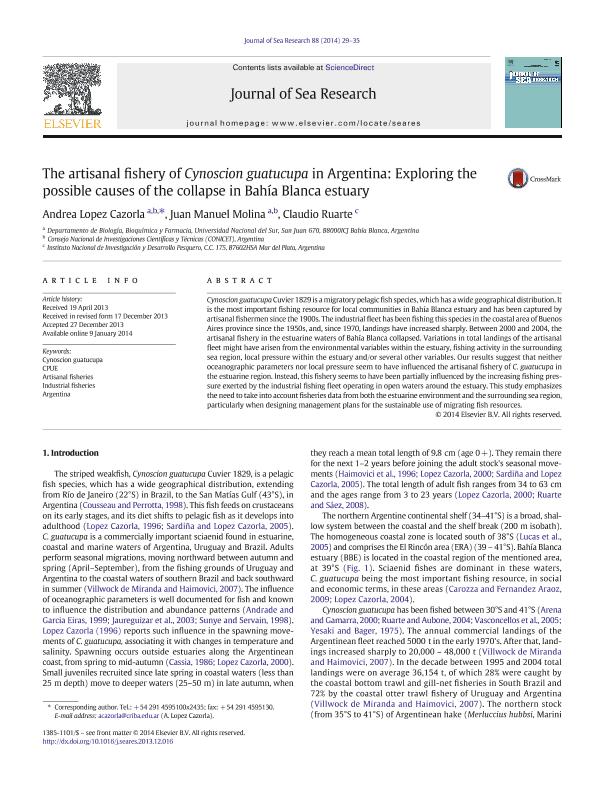Artículo
The artisanal fishery of Cynoscion guatucupa in Argentina: Exploring the possible causes of the collapse in Bahía Blanca estuary
Fecha de publicación:
04/2014
Editorial:
Elsevier Science
Revista:
Journal of Sea Research
ISSN:
1385-1101
Idioma:
Inglés
Tipo de recurso:
Artículo publicado
Clasificación temática:
Resumen
Cynoscion guatucupa Cuvier 1829 is a migratory pelagic fish species, which has a wide geographical distribution. It is the most important fishing resource for local communities in Bahía Blanca estuary and has been captured by artisanal fishermen since the 1900s. The industrial fleet has been fishing this species in the coastal area of Buenos Aires province since the 1950s, and, since 1970, landings have increased sharply. Between 2000 and 2004, the artisanal fishery in the estuarine waters of Bahía Blanca collapsed. Variations in total landings of the artisanal fleet might have arisen from the environmental variables within the estuary, fishing activity in the surrounding sea region, local pressure within the estuary and/or several other variables. Our results suggest that neither oceanographic parameters nor local pressure seem to have influenced the artisanal fishery of C. guatucupa in the estuarine region. Instead, this fishery seems to have been partially influenced by the increasing fishing pressure exerted by the industrial fishing fleet operating in open waters around the estuary. This study emphasizes the need to take into account fisheries data from both the estuarine environment and the surrounding sea region, particularly when designing management plans for the sustainable use of migrating fish resources.
Palabras clave:
Cynoscion Guatucupa
,
Cpue
,
Artisanal Fisheries
,
Industrial Fisheries
,
Argentina
Archivos asociados
Licencia
Identificadores
Colecciones
Articulos(CCT - BAHIA BLANCA)
Articulos de CTRO.CIENTIFICO TECNOL.CONICET - BAHIA BLANCA
Articulos de CTRO.CIENTIFICO TECNOL.CONICET - BAHIA BLANCA
Articulos(INBIOSUR)
Articulos de INSTITUTO DE CIENCIAS BIOLOGICAS Y BIOMEDICAS DEL SUR
Articulos de INSTITUTO DE CIENCIAS BIOLOGICAS Y BIOMEDICAS DEL SUR
Citación
Lopez Cazorla, Andrea Cecilia; Molina, Juan Manuel; Ruarte, Claudio; The artisanal fishery of Cynoscion guatucupa in Argentina: Exploring the possible causes of the collapse in Bahía Blanca estuary; Elsevier Science; Journal of Sea Research; 88; 4-2014; 29-35
Compartir
Altmétricas




